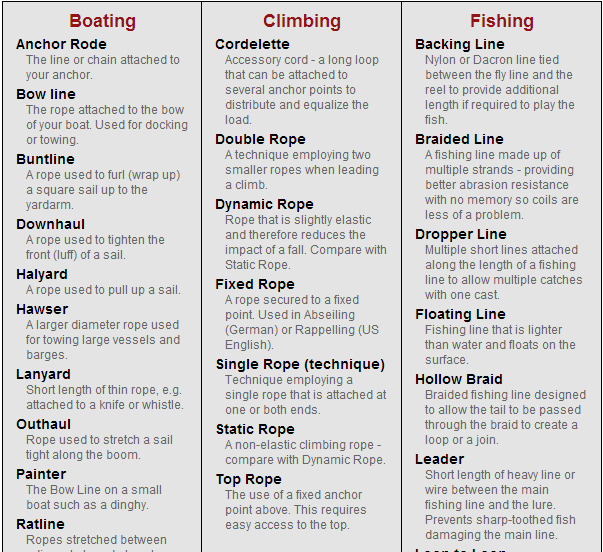Knots Terminology
Names for Ropes and Knots
Terminology for ropes and knots is confusing. Knots are divided into broad categories such as hitches and bends. If you are trying to learn what we have presented here then you may be perfectly happy to call them all knots. However, the correct terminology is useful and worth learning:
- Bend: Joins two ropes or fishing lines, e.g., Sheet Bend, Alpine Butterfly Bend, Figure 8 Bend,Ashley Bend, Hunter's Bend, Zeppelin Bend.
- Bight: Made by folding a piece of rope so that the two parts lie alongside each other. When tied near the rope's end, the parts will be the Tail lying beside the Standing End. A bight can be used to finish many knots - making them easy to untie by just pulling the tail. The term "Bight" does not imply a "Loop" and does not mean the same.
- Bitter End: Derived from the "Bitts" – the stout metal posts used for attaching mooring ropes – it is applied to the tail end of a mooring line.
- Breaking Strain: The theoretical strength of a rope - derived by averaging many tests of a rope tested under optimal conditions, i.e., when stretched slowly while wound many times round a smooth, large diameter drum. The theoretical breaking strain is rarely (if ever) achieved in practice despite claims made by enthusiastic knot proponents.
- Dressing a Knot: Arranging the components of the knot to optimize security and/or strength.
- Flake: To lay a rope out neatly on the deck ready for easy use.
- Frapping Turns: Additional turns added in another axis to bind a Lashing or a Sailmaker's Whipping.
- Hitch: Attaches a rope to something, e.g., a Hitching Post, dock pole, mooring buoy, anchor, or cleat. Such knots include the Rolling Hitch, Cleat Hitch, Buntline Hitch, Icicle Hitch, Distel Hitch, and Lighterman's Hitch.
- Hollow Braid: A loosely woven single-braid rope which can be spliced using a Brummel or aLong Bury technique.
- Kernmantle: A type of rope construction with a Kern (interior core) protected by a Mantle (woven exterior sheath) – a design that achieves abrasion resistance and strength.
- Lay: The direction in which the strands of a rope twist. As the strands progress away from the viewer, if they rotate clockwise like a right hand thread, it is a Right Hand Lay – typically used for most three-strand rope. Steel cables are usually laid with a Left Hand Lay - hence the term Cable Laid, which is used when rope has a Left Hand Lay. If you have become accustomed to splicing three-stranded rope, splicing a piece of cabled-laid rope feels very awkward.
- Loop: Made when a rope forms a partial circle with the ends crossing each other.
- Racking Turns: Lashing turns which pass between poles to bind against the pole better. They are used in Tripod Lashings.
- Round Turn: Two passes of a rope round an object – to completely encircle it.
- Solid Braid: A tightly woven single-braid rope which cannot be spliced using a Brummel or aLong Bury technique.
- Splice: A knot made using the strands of a rope rather than the whole rope – stronger than ordinary knots and intended to be permanent.
- Standing End: The long end - the part not knotted. The standing part lies between the standing end and the knot.
- Stopper Knot: A knot in the end of a rope – used to prevent fraying or to prevent the end passing through a hole.
- Strands: The major components of a rope – three in a three-strand rope. Each "Strand" is made up of many separate fibers.
- Tail; The short end – the part getting knotted.
- Turn: One pass of the rope round or through an object.
- Whipping: A binding knot used to prevent a rope's end fraying.
Similarly, there are many names for rope and line that, particularly in boating, climbing, and fishing, depend on their use:
Source: AnimatedKnots.com



 RSS Feed
RSS Feed